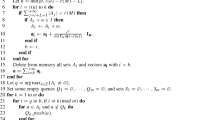Abstract
In a minimum partial set multi-cover problem (MinPSMC), given an element set E, a collection of subsets \({\mathcal {S}} \subseteq 2^E\), a cost \(w_S\) on each set \(S\in {\mathcal {S}}\), a covering requirement \(r_e\) for each element \(e\in E\), and an integer k, the goal is to find a sub-collection \({\mathcal {F}} \subseteq {\mathcal {S}}\) to fully cover at least k elements such that the cost of \({\mathcal {F}}\) is as small as possible, where element e is fully covered by \({\mathcal {F}}\) if it belongs to at least \(r_e\) sets of \({\mathcal {F}}\). On the application side, the problem has its background in the seed selection problem in a social network. On the theoretical side, it is a natural combination of the minimum partial (single) set cover problem (MinPSC) and the minimum set multi-cover problem (MinSMC). Although both MinPSC and MinSMC admit good approximations whose performance ratios match those lower bounds for the classic set cover problem, previous studies show that theoretical study on MinPSMC is quite challenging. In this paper, we prove that MinPSMC cannot be approximated within factor \(O(n^\frac{1}{2(\log \log n)^c})\) for some constant c under the ETH assumption. Furthermore, assuming \(r_{\max }\) is a constant, where \(r_{\max } =\max _{e\in E} r_e\) is the maximum covering requirement and f is the maximum number of sets containing a common element, we present a primal-dual algorithm for MinPSMC and show that its performance ratio is \(O(\sqrt{n})\). We also improve the ratio for a restricted version of MinPSMC which possesses a graph-type structure.
Similar content being viewed by others
References
Bar-Yehuda R, Even S (1985) A local-ratio theorem for approximating the weighted vertex cover problem. N-Holl Math Stud 109:27–45
Bar-Yehuda R (2001) Using homogeneous weights for approximating the partial cover problem. J Algorithms 39:137–144
Bhaskara A, Charikar M, Chlamtac E, Feige U, Vijayaraghavan A (2010) Detecting high log-densities: an \(O(n^{1/4})\) approximation for densest \(k\)-subgraph. In: STOC, pp 201–210
Chen N (2009) On the approximability of influence in social networks. SIAM J Discrete Math 23(3):1400–1415 (A preliminary version appears in SODA’08, 1029–1037)
Chvatal V (1979) A greedy heuristic for the set-covering problem. Math Oper Res 4:233–235
Dinh TN, Shen Y, Nguyen DT, Thai MT (2014) On the approximability of positive influence dominating set in social networks. J Combin Optim 27:487–503
Dinur I, Steurer D (2014) Analytical approach to parallel repetition. In: STOC, pp 624–633
Edmonds J (1970) Submodular functions, matroids, and certain polyhedra. In: Guy R, Hanani H, Sauer N, Schönheim J (eds) Combinatorial structures and their applications. Gordon and Breach, New York, pp 69–87
Feige U (1996) A threshold of \(\ln n\) for approximating set cover. In: STOC, pp 312–318
Fleisher L, Iwata S (2003) A push-relabel framework for submodular function minimization and applications to parametric optimization. Discrete Appl Math 131:311–322
Gandhi R, Khuller S, Srinivasan A (2004) Approximation algorithms for partial covering problems. J Algorithms 53(1):55–84
Hochbaum DS (1982) Approximation algorithms for the set covering and vertex cover problems. SIAM J Comput 11:555–556
Johnson DS (1974) Approximation algorithms for combinatorial problems. J Comput Syst Sci 9:256–278
Karp RM (1972) Reducibility among combinatorial problems. In: Miller RE, Thatcher JW (eds) Complexity of computer computations. Plenum Press, New York, pp 85–103
Kempe D, Kleinberg J, Tardos E (2003) Maximizing the spread of influence through a social network. In: SIGKDD, pp 137–146
Kempe D, Kleinberg J, Tardos E (2005) Influential nodes in a diffusion model for social networks. In: ICALP, pp 1127–1138
Kearns M, Ortiz L (2003) Algorithms for interdependent security games. In: NIPS, pp 288–297
Khot S, Regev O (2008) Vertex cover might be hard to approximate to within \(2-\varepsilon \). J Comput Syst Sci 74(3):335–349
Lovász L (1975) On the ratio of optimal integral and fractional covers. Discret Math 13:383–390
Lovász L (1983) Submodular functions and convexity. In: Bachem A, Korte B, Grötschel M (eds) Mathematical programming the state of the art. Springer, Berlin, pp 235–257
Manurangsi P (2017) Almost-polynomial ratio ETH-hardness of approximating densest \(k\)-subgraph. In: STOC, pp 19–23
Rajagopalan S, Vazirani VV (1993) Primal-dual RNC approximation algorithms for (multi)-set (multi)-cover and covering integer programs. In: FOCS, pp 322–331
Ran Y, Zhang Z, Du H, Zhu Y (2017a) Approximation algorithm for partial positive influence problem in social network. J Combin Optim 33(2):791–802
Ran Y, Shi Y, Zhang Z (2017b) Local ratio method on partial set multi-cover. J Combin Optim 34:302–313
Slavík P (1997) Improved performance of the greedy algorithm for partial cover. Inf Process Lett 64(5):251–254
Vazirani VV (2001) Approximation algorithms. Springer, Berlin
Wang F, Camacho E, Xu K (2009) Positive influence dominating set in online social networks. COCOA LNCS 5573:313–321
Wang F, Du H, Camacho E, Xu K, Lee W, Shi Y, Shan S (2011) On positive influence dominating sets in social networks. Theor Comput Sci 412:265–269
Acknowledgements
A preliminary version of this paper appears in COCOA2018. This research is supported in part by NSFC (11771013, 61751303, 11531011) and the Zhejiang Provincial Natural Science Foundation of China (LD19A010001, LY19A010018).
Author information
Authors and Affiliations
Corresponding author
Additional information
Publisher's Note
Springer Nature remains neutral with regard to jurisdictional claims in published maps and institutional affiliations.
Rights and permissions
About this article
Cite this article
Ran, Y., Shi, Y., Tang, C. et al. A primal-dual algorithm for the minimum partial set multi-cover problem. J Comb Optim 39, 725–746 (2020). https://doi.org/10.1007/s10878-019-00513-y
Published:
Issue Date:
DOI: https://doi.org/10.1007/s10878-019-00513-y




